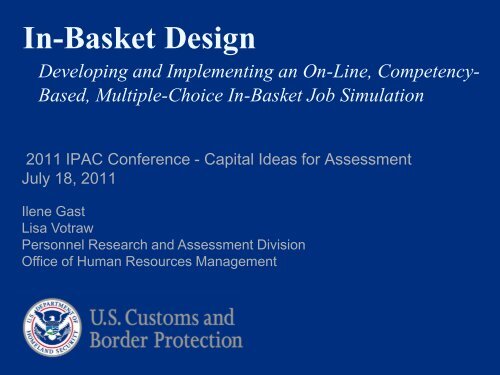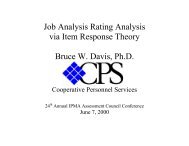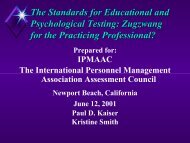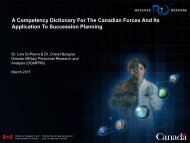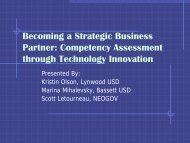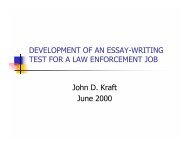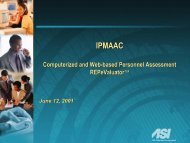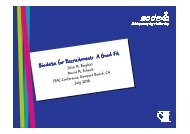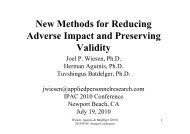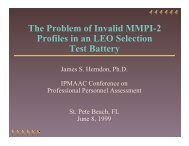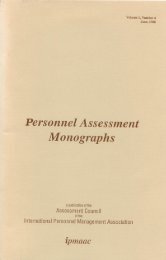In-Basket Design: Developing and Implementing an On-Line ... - IPAC
In-Basket Design: Developing and Implementing an On-Line ... - IPAC
In-Basket Design: Developing and Implementing an On-Line ... - IPAC
Create successful ePaper yourself
Turn your PDF publications into a flip-book with our unique Google optimized e-Paper software.
<strong>In</strong>-<strong>Basket</strong> <strong>Design</strong><br />
<strong>Developing</strong> <strong><strong>an</strong>d</strong> <strong>Implementing</strong> <strong>an</strong> <strong>On</strong>-<strong>Line</strong>, Competency-<br />
Based, Multiple-Choice <strong>In</strong>-<strong>Basket</strong> Job Simulation<br />
2011 <strong>IPAC</strong> Conference - Capital Ideas for Assessment<br />
July 18, 2011<br />
Ilene Gast<br />
Lisa Votraw<br />
Personnel Research <strong><strong>an</strong>d</strong> Assessment Division<br />
Office of Hum<strong>an</strong> Resources M<strong>an</strong>agement
Session Goals<br />
• Outline the steps for developing a competency-based<br />
multiple-choice in-basket assessment<br />
• <strong>In</strong>structions <strong><strong>an</strong>d</strong> Overview<br />
• E-mail messages<br />
• Multiple-choice questions<br />
• Documentation<br />
• Emphasize procedures for ensuring validity<br />
• Traditional job <strong>an</strong>alysis<br />
• Competency-based job <strong>an</strong>alysis<br />
• Generic competency <strong><strong>an</strong>d</strong> assessment specific perform<strong>an</strong>ce<br />
benchmarks<br />
<strong>IPAC</strong> Annual Conference 2011 2
What is the <strong>In</strong>-<strong>Basket</strong> Assessment<br />
• The <strong>In</strong>-<strong>Basket</strong> Assessment provides a snapshot of a<br />
supervisor’s or m<strong>an</strong>ager’s duties <strong><strong>an</strong>d</strong> responsibilities<br />
• The Overview <strong><strong>an</strong>d</strong> E-mail Messages incorporate tasks<br />
<strong><strong>an</strong>d</strong> duties typically performed by job incumbents<br />
• The Multiple-choice Questions target critical<br />
competencies<br />
• Successful perform<strong>an</strong>ce depends on proficiency in critical<br />
competencies<br />
<strong>IPAC</strong> Annual Conference 2011 3
Who Takes the <strong>In</strong>-<strong>Basket</strong> Assessment<br />
U.S. Customs <strong><strong>an</strong>d</strong> Border Protection<br />
• Supervisory Border Patrol Agents (GS-1896-13/15)<br />
• Supervisory CBP Officers (GS-1895-13/14)<br />
• Supervisory CBP Agriculture Specialists (GS-1895-13/14)<br />
U.S. Immigration <strong><strong>an</strong>d</strong> Customs Enforcement<br />
• Supervisory/M<strong>an</strong>agerial Special Agents (GS-14)<br />
<strong>IPAC</strong> Annual Conference 2011 4
The Steps<br />
• Step 1: Determine Critical Tasks, Duties,<br />
<strong><strong>an</strong>d</strong> Competencies<br />
• Step 2: Collect Source Materials<br />
• Step 3: Develop Overview <strong><strong>an</strong>d</strong> E-mail Messages<br />
• Step 4: Develop Perform<strong>an</strong>ce Benchmarks<br />
• Step 5: Write Multiple-Choice Questions<br />
<strong>IPAC</strong> Annual Conference 2011 5
The Steps<br />
• Step 6: Confirm Fidelity <strong><strong>an</strong>d</strong> Job Relatedness<br />
• Step 7: Assemble, Review, <strong><strong>an</strong>d</strong> Finalize<br />
• Step 8: Prepare for <strong>On</strong>-<strong>Line</strong> Administration<br />
• Step 9: Administer the <strong>In</strong>-<strong>Basket</strong><br />
• Step 10: Conduct Key Clear<strong>an</strong>ce<br />
<strong>IPAC</strong> Annual Conference 2011 6
Step 1: Determine Critical Tasks, Duties,<br />
<strong><strong>an</strong>d</strong> Competencies<br />
Validity evidence is based on test content<br />
• The <strong>In</strong>-<strong>Basket</strong> is grounded in comprehensive job <strong>an</strong>alysis<br />
• SMEs identify critical tasks, duties, <strong><strong>an</strong>d</strong> competencies<br />
<strong><strong>an</strong>d</strong> perform a duty/competency linkage<br />
• Validity relies on comprehensive sampling of critical tasks<br />
<strong><strong>an</strong>d</strong> duties <strong><strong>an</strong>d</strong> critical competencies<br />
• The overview <strong><strong>an</strong>d</strong> e-mail messages incorporate tasks<br />
<strong><strong>an</strong>d</strong> duties typically performed by job incumbents<br />
• The multiple-choice questions target critical<br />
competencies<br />
<strong>IPAC</strong> Annual Conference 2011 7
Step 1: Determine Critical Tasks, Duties,<br />
<strong><strong>an</strong>d</strong> Competencies<br />
Conduct a Job/Task Analysis<br />
• Duties <strong><strong>an</strong>d</strong> tasks guide the development of in-basket<br />
content<br />
CBP Critical Supervisory <strong><strong>an</strong>d</strong> M<strong>an</strong>agerial Duties<br />
• Technical/Operations<br />
• Budget <strong><strong>an</strong>d</strong> Fin<strong>an</strong>ce<br />
• Resource M<strong>an</strong>agement<br />
• Hum<strong>an</strong> Resource M<strong>an</strong>agement<br />
• Public Relations<br />
<strong>IPAC</strong> Annual Conference 2011 8
Step 1: Determine Critical Tasks, Duties,<br />
<strong><strong>an</strong>d</strong> Competencies<br />
Develop or Adopt a Competency Model<br />
Competencies guide all phases of in-basket development<br />
• The collection of source materials<br />
• The identification of issues addressed by c<strong><strong>an</strong>d</strong>idates<br />
• The generation of in-basket content (overview & e-mail<br />
messages)<br />
• The development of multiple-choice questions<br />
• The calibration of the scoring key<br />
<strong>IPAC</strong> Annual Conference 2011 9
Supervisory/M<strong>an</strong>agerial Competency Model<br />
U.S. Customs <strong><strong>an</strong>d</strong> Border Protection<br />
The <strong>In</strong>-<strong>Basket</strong> focuses M<strong>an</strong>agement Skills <strong><strong>an</strong>d</strong> Applied Thinking Skills<br />
Leadership<br />
• Flexibility<br />
• Fostering Ethical Conduct<br />
• Leading Others<br />
• M<strong>an</strong>aging Conflict<br />
• Teaching Others<br />
• Teambuilding<br />
Thinking<br />
• Continual Learning<br />
• Decision-Making/Problem Solving<br />
• External Awareness<br />
• <strong>In</strong>novation<br />
• Org<strong>an</strong>izational Awareness<br />
• Reasoning<br />
M<strong>an</strong>agement<br />
• Fin<strong>an</strong>cial M<strong>an</strong>agement<br />
• Hum<strong>an</strong> Resource M<strong>an</strong>agement<br />
• M<strong>an</strong>aging & Org<strong>an</strong>izing <strong>In</strong>formation<br />
• Pl<strong>an</strong>ning & Resource M<strong>an</strong>agement<br />
• Perform<strong>an</strong>ce <strong><strong>an</strong>d</strong> Results<br />
Measurement<br />
• Self-M<strong>an</strong>agement<br />
• Technology Application<br />
Communication<br />
• Collaboration<br />
• <strong>In</strong>fluencing & Negotiating<br />
• <strong>In</strong>terpersonal Skills<br />
• Oral Communication<br />
• Written Communication<br />
<strong>IPAC</strong> Annual Conference 2011<br />
10
Step 2: Collect Source Materials<br />
• Review readily available information<br />
• Position descriptions<br />
• Training m<strong>an</strong>uals <strong><strong>an</strong>d</strong> operational h<strong><strong>an</strong>d</strong>books<br />
• <strong>In</strong>formation from <strong>In</strong>ternet/<strong>In</strong>tr<strong>an</strong>et<br />
• Materials from other assessment development efforts<br />
• Collect information from representative locations<br />
• Type of facility<br />
• Geographic location<br />
• Work cycle<br />
<strong>IPAC</strong> Annual Conference 2011<br />
11
Step 2: Collect Source Materials<br />
Work with SMEs, Superiors, <strong>In</strong>cumbents, Direct-Reports<br />
• Gather representative documents<br />
• E-mail messages<br />
• Memos<br />
• Org<strong>an</strong>izational charts<br />
• Forms<br />
• Collect critical incidents (war stories)<br />
• What happened<br />
• Antecedents—Behaviors—Consequences (ABC’s)<br />
• How effective was the incumbent’s behavior<br />
• C<strong>an</strong> you provide examples of more or less effective responses<br />
<strong>IPAC</strong> Annual Conference 2011<br />
12
Step 2: Collect Source Materials<br />
Work with SMEs, Superiors, <strong>In</strong>cumbents, Direct-Reports<br />
• Conduct competency-based ―typical day‖ interviews:<br />
“Tell me about some of the issues you might h<strong><strong>an</strong>d</strong>le on a typical day”<br />
• How did you find out about this issue Who did you inform<br />
about this issue (M<strong>an</strong>aging & Org<strong>an</strong>izing <strong>In</strong>formation)<br />
• What actions did you take to resolve this issue (Decision-<br />
Making/Problem-Solving)<br />
• Who did you delegate this to (Self-M<strong>an</strong>agement)<br />
• What, if <strong>an</strong>y, follow up did you do to evaluate the resolution of<br />
the issue (Perform<strong>an</strong>ce & Results M<strong>an</strong>agement)<br />
<strong>IPAC</strong> Annual Conference 2011<br />
13
Step 3: Develop Overview <strong><strong>an</strong>d</strong> E-mail Messages<br />
The overview sets the stage for the in-basket<br />
• The overview includes:<br />
• The c<strong><strong>an</strong>d</strong>idate’s role <strong><strong>an</strong>d</strong> responsibilities<br />
• You are Pat Jones, the m<strong>an</strong>ager of . . .<br />
• The time frame<br />
• It is 8:00 a.m. on Tuesday, July 20th. You have been on leave<br />
for the past 2 weeks. <strong>In</strong> 40 minutes you must leave for <strong>an</strong> allday<br />
meeting.<br />
• The org<strong>an</strong>izational setting<br />
• Location <strong><strong>an</strong>d</strong> surroundings<br />
• Org<strong>an</strong>izational structure <strong><strong>an</strong>d</strong> staff<br />
• Critical issues<br />
<strong>IPAC</strong> Annual Conference 2011<br />
14
Step 3: Develop Overview <strong><strong>an</strong>d</strong> E-mail Messages<br />
Create a bal<strong>an</strong>ced pool of e-mail messages<br />
• Cover job duties <strong><strong>an</strong>d</strong> critical tasks<br />
• Address critical competencies<br />
• Vary document features<br />
• Sender<br />
• Org<strong>an</strong>ization<br />
• Org<strong>an</strong>izational level<br />
• Origination date<br />
• Priority/criticality<br />
Create more e-mail messages th<strong>an</strong> you think you need!<br />
<strong>IPAC</strong> Annual Conference 2011<br />
15
Step 4: Develop Perform<strong>an</strong>ce Benchmarks<br />
The <strong>In</strong>-<strong>Basket</strong> Uses Two Types of Benchmarks<br />
• Generic competency benchmarks<br />
• Developed by PRAD to apply across all PROM<br />
occupations<br />
• Defined in PRAD taxonomy at the subcompetency level<br />
• Specific e-mail benchmarks<br />
• Developed by SMEs for each new in-basket<br />
<strong>IPAC</strong> Annual Conference 2011<br />
16
Step 4: Develop Perform<strong>an</strong>ce Benchmarks<br />
Generic Competency Benchmarks<br />
• Characteristics<br />
• Applicable to future assessments<br />
• Applicable to other occupations<br />
• Process<br />
• Analyze the competency definition<br />
• Think about perform<strong>an</strong>ce requirements<br />
• List the behaviors that define perform<strong>an</strong>ce<br />
• For each behavior, provide perform<strong>an</strong>ce benchmarks<br />
(exceptional, meets expectations, needs improvement)<br />
• Use for scaling multiple-choice response options<br />
<strong>IPAC</strong> Annual Conference 2011<br />
17
Step 4: Develop Perform<strong>an</strong>ce Benchmarks<br />
Generic Competency Benchmarks -- Example<br />
• Competency Definition<br />
M<strong>an</strong>aging <strong><strong>an</strong>d</strong> Org<strong>an</strong>izing <strong>In</strong>formation - Identifies need for<br />
information; determines its import<strong>an</strong>ce <strong><strong>an</strong>d</strong> accuracy, <strong><strong>an</strong>d</strong><br />
communicates it by a variety of methods.<br />
• Subcompetencies<br />
1 Recognizes when available information is incomplete, inaccurate, or<br />
contains conflicts.<br />
2 Determines appropriate disposition of information.<br />
3 Recognizes relationships among documents.<br />
<strong>IPAC</strong> Annual Conference 2011<br />
18
Step 4: Develop Perform<strong>an</strong>ce Benchmarks<br />
Generic Competency Benchmarks -- Example<br />
M<strong>an</strong>aging <strong><strong>an</strong>d</strong> Org<strong>an</strong>izing <strong>In</strong>formation - Identifies need for<br />
information; determines its import<strong>an</strong>ce <strong><strong>an</strong>d</strong> accuracy, <strong><strong>an</strong>d</strong><br />
communicates it by a variety of methods.<br />
1. Recognizes when available information is incomplete,<br />
inaccurate, or contains conflicts.<br />
Benchmark example to be provided during tutorial.<br />
<strong>IPAC</strong> Annual Conference 2011<br />
19
Step 4: Develop Perform<strong>an</strong>ce Benchmarks<br />
Specific E-mail Benchmarks<br />
• Are developed by well qualified SMEs<br />
• Have held the target position<br />
• Are not eligible to take the test<br />
– Are currently at target level or higher<br />
• Are recognized as competent<br />
• Define possible actions that c<strong>an</strong> be taken in response to<br />
each e-mail message<br />
• Form basis of multiple-choice response options<br />
• Competency benchmarks help to calibrate response options<br />
<strong>IPAC</strong> Annual Conference 2011<br />
20
Step 4: Develop Perform<strong>an</strong>ce Benchmarks<br />
SME Content Review <strong><strong>an</strong>d</strong> Benchmark Development<br />
• SMEs provide preliminary review of in-basket materials<br />
• Respond to in-basket in ―c<strong><strong>an</strong>d</strong>idate mode‖<br />
• Rate job-relatedness, technical accuracy, format, clarity<br />
• Suggest ch<strong>an</strong>ges to improve fidelity<br />
• SMEs develop perform<strong>an</strong>ce benchmarks<br />
• Focus SME responses with competency-based probes<br />
Specific issues (e-mail messages)<br />
Broader issues (overall in-basket)<br />
• Define perform<strong>an</strong>ce levels<br />
Highly effective<br />
Marginally acceptable<br />
<strong>In</strong>effective<br />
<strong>IPAC</strong> Annual Conference 2011<br />
21
Step 4: Develop Perform<strong>an</strong>ce Benchmarks<br />
Competency-based probes help SMEs generate benchmarks<br />
M<strong>an</strong>aging <strong><strong>an</strong>d</strong> Org<strong>an</strong>izing <strong>In</strong>formation - Identifies need for<br />
information; determines its import<strong>an</strong>ce <strong><strong>an</strong>d</strong> accuracy, <strong><strong>an</strong>d</strong><br />
communicates it by a variety of methods.<br />
Consider the following questions as you review each document:<br />
• Does the information in this document provide insight into issues<br />
presented in other documents<br />
• Who else needs the information presented in this document How soon<br />
must you present this information to these individuals<br />
• What should you do with this document once you have read it Do you<br />
need to tr<strong>an</strong>smit it to or inform others this document Should it be filed<br />
C<strong>an</strong> you discard it<br />
<strong>IPAC</strong> Annual Conference 2011<br />
22
Step 5: Write Multiple-Choice Questions<br />
• Prepare the test pl<strong>an</strong><br />
• Select the best e-mail messages<br />
• Write questions <strong><strong>an</strong>d</strong> response options<br />
• Prepare <strong>an</strong>swer key <strong><strong>an</strong>d</strong> justification of correct <strong><strong>an</strong>d</strong><br />
incorrect responses<br />
<strong>IPAC</strong> Annual Conference 2011<br />
23
Step 5: Write Multiple-Choice Questions<br />
Prepare the Test Pl<strong>an</strong><br />
• Weight each competency based on job <strong>an</strong>alysis results<br />
• Set test length <strong><strong>an</strong>d</strong> determine the number of items needed for<br />
each competency<br />
• Write more questions th<strong>an</strong> you need<br />
# of Questions<br />
Competency Draft Final<br />
Decision-Making 20 18<br />
Pl<strong>an</strong>ning & Resource M<strong>an</strong>agement 15 13<br />
Perf. & Results M<strong>an</strong>agement 15 13<br />
M<strong>an</strong>aging <strong>In</strong>formation 20 16<br />
Self-M<strong>an</strong>agement 20 15<br />
Total 90 75<br />
1 Assumes that 2 forms will be developed <strong><strong>an</strong>d</strong> that there will be about<br />
40-50% overlap between the forms.<br />
<strong>IPAC</strong> Annual Conference 2011<br />
24
Step 5: Write Multiple-Choice Questions<br />
Select the Best E-mail Messages<br />
• Each e-mail message should . . .<br />
• Look <strong><strong>an</strong>d</strong> feel like the job<br />
• Address at least one critical competency<br />
• The pool of e-mail messages should . . .<br />
• Sample the domain of critical duties <strong><strong>an</strong>d</strong> work activities<br />
• Vary in ―sender‖ <strong><strong>an</strong>d</strong> priority<br />
• Be able to be read within time limits<br />
• Average reading speed = 300 words/minute<br />
• 25 - 30 e-mail messages = about 30 minutes<br />
• Reserve ―back-up‖ e-mail messages<br />
• E-mail messages will be eliminated during item writing <strong><strong>an</strong>d</strong><br />
test reviews<br />
<strong>IPAC</strong> Annual Conference 2011<br />
25
Step 5: Write Multiple-Choice Questions<br />
Write Questions <strong><strong>an</strong>d</strong> Response Options<br />
• Develop competency-based stems<br />
• Use ―competency-based probes‖ to guide development<br />
• Develop response options<br />
• E-mail based benchmarks define highly effective, marginally<br />
acceptable, <strong><strong>an</strong>d</strong> unacceptable perform<strong>an</strong>ce<br />
• Sub-competency benchmarks help calibrate responses<br />
• All response options must address the same competency<br />
Guideline<br />
• Each e-mail message should produce at least 1 item<br />
• If not, delete or revise the document<br />
• Consider the impact on other e-mail messages!<br />
• Tell the other item writers!<br />
<strong>IPAC</strong> Annual Conference 2011<br />
26
Step 5: Write Multiple-Choice Questions<br />
Sample E-mail Message # 3<br />
From: SBPA St<strong>an</strong> Markowitz<br />
To: Chief Patrol Agent Chris Smith<br />
Subject: Questions from Media<br />
Assist<strong>an</strong>t Chief Sus<strong>an</strong> Cook called at 6:30 this morning from Sector Headquarters.<br />
She was unable to reach you. She got a call from Dick Grady a reporter from<br />
KNWS-Talk Radio. He asked AC Cook to comment on our strategy for this week’s<br />
joint operation with DEA. AC Cook said that Dick Grady knows much more about<br />
our pl<strong>an</strong>s for Operation CATTRAP th<strong>an</strong> we have released to the public.<br />
AC Cook referred Dick Grady to our Public <strong>In</strong>formation Officer <strong><strong>an</strong>d</strong> then asked him<br />
where he obtained his information. He said he could not reveal his sources. She<br />
asked me to pass this information on to you ASAP <strong><strong>an</strong>d</strong> to ask you to h<strong><strong>an</strong>d</strong>le the<br />
situation.<br />
If you need me, I will be on location for the remainder of the day.<br />
<strong>IPAC</strong> Annual Conference 2011<br />
27
Step 5: Write Multiple-Choice Questions<br />
Competency: Problem Solving <strong><strong>an</strong>d</strong> Decision-Making<br />
• Identifies <strong><strong>an</strong>d</strong> <strong>an</strong>alyzes problems; distinguishes between<br />
relev<strong>an</strong>t <strong><strong>an</strong>d</strong> irrelev<strong>an</strong>t information to make logical<br />
judgments; provides solutions to individual <strong><strong>an</strong>d</strong> org<strong>an</strong>izational<br />
problems; draws correct inferences from available information to<br />
make sound <strong><strong>an</strong>d</strong> well-informed decisions.<br />
Subcompetency: Assesses the relev<strong>an</strong>ce of information<br />
Benchmarks to be provided during tutorial.<br />
<strong>IPAC</strong> Annual Conference 2011<br />
28
Step 5: Write Multiple-Choice Questions<br />
Sample Decision-Making Item<br />
• <strong>In</strong> E-mail 3, Supervisory Border Patrol Agent (SBPA) Markowitz<br />
informs you that a reporter has asked Assist<strong>an</strong>t Chief Sus<strong>an</strong><br />
Cook for comments on Operation CATTRAP. What is the most<br />
critical issue raised in this message<br />
A) Assist<strong>an</strong>t Chief Cook’s inability to reach you.<br />
B) SBPA Markowitz’s location for the remainder of the day<br />
C) Assist<strong>an</strong>t Chief Cook’s inability to reach you this<br />
morning.<br />
D) Dick Grady’s knowledge about Operation CATTRAP.<br />
E) Dick Grady’s refusal to divulge the source of his<br />
knowledge about Operation CATTRAP.<br />
<strong>IPAC</strong> Annual Conference 2011<br />
29
Step 5: Write Multiple-Choice Questions<br />
Prepare Answer Key <strong><strong>an</strong>d</strong> Justification<br />
• For each question, include<br />
• Assigned test series <strong><strong>an</strong>d</strong> respective question #<br />
• Is it <strong>an</strong> ―<strong>an</strong>chor item‖<br />
• Competency/subcompetency<br />
• E-mail message(s) referenced<br />
• Question stem<br />
• Response options <strong><strong>an</strong>d</strong> key (correct response)<br />
• Justification for each response option<br />
<strong>IPAC</strong> Annual Conference 2011<br />
30
Step 5: Write Multiple-Choice Questions<br />
Job Simulation Question Development Worksheet<br />
Development<br />
Number:<br />
Item #2 Question Number: Series 110 Item #2<br />
Documents Used: Document #3 Series 120 Item #4<br />
Primary Competency<br />
Measured:<br />
X Decision Making<br />
Pl<strong>an</strong>ning <strong><strong>an</strong>d</strong><br />
Evaluating<br />
Documentation:<br />
Text Format<br />
M<strong>an</strong>aging <strong>In</strong>formation<br />
Item Stem <strong><strong>an</strong>d</strong> Alternatives<br />
Self-M<strong>an</strong>agement<br />
<strong>In</strong> Document 3, SBPA Markowitz informs you of <strong>an</strong> urgent telephone call he received from<br />
Assist<strong>an</strong>t Chief Cook last night. What is the MOST critical issue raised in this document<br />
Key<br />
0<br />
0<br />
0<br />
2<br />
0<br />
A) Dick Grady’s invitation to Assist<strong>an</strong>t Chief Cook<br />
B) SBPA Markowitz’s location for the remainder of the day<br />
C) Assist<strong>an</strong>t Chief Cook’s inability to reach you last night<br />
D) Dick Grady’s knowledge about Operation CATTRAP<br />
E) Dick Grady’s refusal to divulge the source of his knowledge about Operation<br />
CATTRAP<br />
Expl<strong>an</strong>ation<br />
Key: Justification for correct <strong>an</strong>swer goes here<br />
Option D is the best <strong>an</strong>swer. The most critical piece of information is the fact that Dick Grady<br />
has more extensive knowledge of Operation CATTRAP th<strong>an</strong> has been released to the public.<br />
The fact that Dick Grady has invited Assist<strong>an</strong>t Chief Cook to appear on his radio program.<br />
Other Response Options: Justification for incorrect <strong>an</strong>swers go here<br />
(A) This option is less import<strong>an</strong>t; it is Assist<strong>an</strong>t Chief Cook’s decision whether to accept the<br />
invitation.<br />
(B) SBPA Markowitz’s whereabouts are known <strong><strong>an</strong>d</strong> he c<strong>an</strong> be contacted if needed; therefore,<br />
this information c<strong>an</strong>not be considered as critical.<br />
(C) Assist<strong>an</strong>t Chief Cook’s inability to reach you last night is now irrelev<strong>an</strong>t because you have<br />
been contacted.<br />
(E) Dick Grady’s refusal to divulge his source is less critical th<strong>an</strong> the fact that he knows a great<br />
deal about Operation CATTRAP.<br />
Reviewer’s Comments<br />
Reviewer’s <strong>In</strong>itials<br />
JC<br />
<strong>IPAC</strong> Annual Conference 2011<br />
31
Step 5: Write Multiple-Choice Questions<br />
Documentation: Spreadsheet Format<br />
<strong>IPAC</strong> Annual Conference 2011<br />
32
Step 6: Confirm Fidelity <strong><strong>an</strong>d</strong> Job Relatedness<br />
Assemble Materials for SME Review<br />
• <strong>In</strong>-basket<br />
• Overview<br />
– Org<strong>an</strong>izational chart<br />
– Background information<br />
– Calendars<br />
• Over-length test<br />
– All multiple-choice questions<br />
• Documentation of response options<br />
• Unresolved issues for SMEs to address<br />
• Policy<br />
• Job knowledge<br />
<strong>IPAC</strong> Annual Conference 2011<br />
33
Step 6: Confirm Fidelity <strong><strong>an</strong>d</strong> Job Relatedness<br />
Conduct SME Review Session<br />
• SMEs complete the assessment<br />
• Read overview/e-mail messages<br />
• Complete over-long test<br />
• Review <strong><strong>an</strong>d</strong> revise the overview <strong><strong>an</strong>d</strong> e-mail messages<br />
• Review <strong><strong>an</strong>d</strong> revise questions <strong><strong>an</strong>d</strong> documentation<br />
• Reflect ch<strong>an</strong>ges to overview <strong><strong>an</strong>d</strong> e-mail messages in<br />
multiple-choice questions<br />
• Delete questions corresponding to deleted e-mail messages<br />
• Modify response options<br />
• Provide additional documentation<br />
<strong>IPAC</strong> Annual Conference 2011<br />
34
Step 6: Confirm Fidelity <strong><strong>an</strong>d</strong> Job Relatedness<br />
• SMEs evaluate all in-basket materials for:<br />
• Job relatedness<br />
• Clarity/conciseness<br />
• Technical accuracy<br />
• Fidelity<br />
• Multiple-choice questions receive additional scrutiny<br />
• Generalizability across settings<br />
– Must generalize across facility type <strong><strong>an</strong>d</strong> geographic location<br />
– C<strong>an</strong>not rely on localized knowledge or regional policies<br />
• Soundness of <strong>an</strong>swer key <strong><strong>an</strong>d</strong> justification of responses<br />
– Keyed <strong>an</strong>swer must be the best <strong>an</strong>swer<br />
– Other response options must be plausible<br />
If SMEs alter a response option make sure that it addresses the intended<br />
competency!<br />
<strong>IPAC</strong> Annual Conference 2011<br />
35
Step 7: Assemble, Review, <strong><strong>an</strong>d</strong> Finalize<br />
Assemble Alternate Forms<br />
A True Bal<strong>an</strong>cing Act<br />
• Both forms must follow the competencybased<br />
test pl<strong>an</strong><br />
• Each document must be addressed by at<br />
least one multiple-choice question<br />
• <strong>On</strong>e question c<strong>an</strong>not imply the <strong>an</strong>swer to<br />
other questions<br />
• Response options should be equally<br />
distributed<br />
• Each option (A,B,C,D,E) will comprise about<br />
20% of the total<br />
• Response options should be appropriately<br />
sequenced<br />
• no more th<strong>an</strong> 3 ―A’s,‖ ―B’s,‖ ―C’s,‖ etc. in a row<br />
<strong>IPAC</strong> Annual Conference 2011<br />
36
Step 7: Assemble, Review, <strong><strong>an</strong>d</strong> Finalize<br />
• Write instructions for administration<br />
• <strong>On</strong>-line<br />
• Paper-<strong><strong>an</strong>d</strong>-pencil<br />
• Quality control: Proofread!!<br />
• Look for common mistakes – watch for inconsistencies<br />
– Names of characters<br />
– Names of places<br />
– Dates/times<br />
– E-mail format<br />
―the details‖<br />
<strong>IPAC</strong> Annual Conference 2011<br />
37
Step 7: Assemble, Review, <strong><strong>an</strong>d</strong> Finalize<br />
Technical (Psychometric) Review<br />
• Examine instructions, introductory materials, e-mail messages<br />
• Sensitive org<strong>an</strong>izational issues<br />
• Conform<strong>an</strong>ce to org<strong>an</strong>izational policies, practices,<br />
procedures<br />
• Grammar, syntax, clarity<br />
• Review/edit multiple-choice items<br />
• Grammar, syntax, clarity<br />
• Correspondence to competency<br />
• <strong>In</strong>dependence of response options<br />
• Review/edit scoring key<br />
<strong>IPAC</strong> Annual Conference 2011<br />
38
Step 8: Prepare for Administration<br />
• <strong>On</strong>-line administration<br />
• Program the in-basket for on-line administration<br />
• Allow enough time–PRAD’s contractor requires 8 weeks<br />
• Conduct User Accept<strong>an</strong>ce Testing (UAT)<br />
• Preliminary review<br />
• Contractor’s Quality Assur<strong>an</strong>ce (QA) team<br />
• PRAD test developers<br />
• Live review<br />
• Conducted by PRAD one week before testing<br />
• Paper-<strong><strong>an</strong>d</strong>-pencil administration<br />
• Prepare Directions for Conducting (DFC)<br />
• Prepare master copy for reproduction or printing<br />
<strong>IPAC</strong> Annual Conference 2011<br />
39
Step 9: Administer the <strong>In</strong>-<strong>Basket</strong><br />
<strong>IPAC</strong> Annual Conference 2011<br />
40
Step 9: Administer the <strong>In</strong>-<strong>Basket</strong><br />
C<strong><strong>an</strong>d</strong>idates register for the assessment during <strong>an</strong> open period<br />
• <strong>On</strong>-line version<br />
• Administered in multiple testing sites nationwide<br />
• Self-paced administration in a proctored environment<br />
• Total test time is 90 minutes<br />
• Up to 40 minutes for review of overview <strong><strong>an</strong>d</strong> documents<br />
• Remainder of period for multiple-choice questions<br />
• Paper-<strong><strong>an</strong>d</strong>-pencil version<br />
• Used for international administration <strong><strong>an</strong>d</strong> in making<br />
reasonable accommodations<br />
• Not self-paced<br />
• 40 minutes for review of overview <strong><strong>an</strong>d</strong> documents<br />
• 50 minutes to complete multiple choice-questions<br />
<strong>IPAC</strong> Annual Conference 2011<br />
41
Step 10: Conduct Key Clear<strong>an</strong>ce<br />
• Prior to assigning scores, we examine item functioning to:<br />
• Verify the accuracy of the computer-programmed scoring key<br />
• Evaluate the integrity of each item<br />
• What we examine<br />
• Item difficulty (p-values)<br />
• Point biserial correlations (pbi)<br />
• Hi/Lo Split (response distribution of upper <strong><strong>an</strong>d</strong> lower 45%)<br />
• <strong>In</strong>ternal consistency reliability<br />
• Content of question stems <strong><strong>an</strong>d</strong> response options<br />
• Decisions we make based on item statistics <strong><strong>an</strong>d</strong> content review<br />
• Poorly performing items are eliminated<br />
• Alternative plausible responses receive full or partial credit<br />
<strong>IPAC</strong> Annual Conference 2011<br />
42
Step 10: Conduct Key Clear<strong>an</strong>ce<br />
Questions we ask during key clear<strong>an</strong>ce:<br />
• Item difficulty (p-values)<br />
• What percent of c<strong><strong>an</strong>d</strong>idates select the keyed response<br />
• Is the item overly difficult or too easy<br />
• Item point biserial correlations<br />
• Does highest pbi correspond to the keyed response<br />
• Variation within the distribution of response options<br />
• How often is each response option being endorsed<br />
• Are ―top‖ c<strong><strong>an</strong>d</strong>idates endorsing the keyed response<br />
• Which response options are being endorsed by poorer<br />
performers<br />
• <strong>In</strong>ternal consistency reliability<br />
• What would happen if a low performing item was dropped<br />
<strong>IPAC</strong> Annual Conference 2011<br />
43
Don’t Forget to Cle<strong>an</strong> House!<br />
Assemble documentation for future reference<br />
<strong>In</strong>clude hard <strong><strong>an</strong>d</strong> electronic copies of:<br />
• in-basket materials<br />
• <strong>In</strong>structions <strong><strong>an</strong>d</strong> Overview<br />
• E-mail messages<br />
• All test series (e.g., 130 & 140)<br />
• Key <strong><strong>an</strong>d</strong> documentation<br />
• Item-level statistics<br />
• include items that are not scored<br />
Shred/destroy what you don’t need!<br />
<strong>IPAC</strong> Annual Conference 2011<br />
44
References<br />
Americ<strong>an</strong> Educational Research Association,<br />
Americ<strong>an</strong> Psychological Association, <strong><strong>an</strong>d</strong><br />
National Council for Measurement in<br />
Education (1999). St<strong><strong>an</strong>d</strong>ards for<br />
educational <strong><strong>an</strong>d</strong> psychological testing.<br />
Washington, DC: Americ<strong>an</strong> Educational<br />
Research Association.<br />
Anastasi, A. (1988) Psychological Testing (6 th<br />
ed.). New York, NY: Macmill<strong>an</strong><br />
Publishing Co.<br />
Downs, S., Farr, R.M., & Colbeck, L. (1978).<br />
Self appraisal: A convergence of<br />
selection <strong><strong>an</strong>d</strong> guid<strong>an</strong>ce. Journal of<br />
Occupational Psychology, 51, 271-278.<br />
Frederiksen, D.R., Saunders, & W<strong><strong>an</strong>d</strong>, B.<br />
(1957). The in-basket test. Psychological<br />
Monographs, 71, 9, (whole no. 438).<br />
Gronlund, Norm<strong>an</strong> E. (1988). How to<br />
construct achievement tests (4 th ed.).<br />
Englewood Cliffs, NJ: Prentice-Hall, <strong>In</strong>c.<br />
Hakel, M.D. (Ed) (1998). Beyond multiplechoice:<br />
Evaluating alternatives to<br />
traditional testing for selection. Mahwah,<br />
NJ: Lawrence Erlbaum Associates, <strong>In</strong>c.,<br />
Publishers<br />
Haladyna, T.M. (1999). <strong>Developing</strong> <strong><strong>an</strong>d</strong><br />
validating multiple-choice test items (2nd<br />
ed.). Mahwah, NJ: Lawrence Erlbaum<br />
Associates, <strong>In</strong>c., Publishers.<br />
Kesselm<strong>an</strong>, G.A., Lopez, F.M., & Lopez, F.E.<br />
(1982). The development <strong><strong>an</strong>d</strong> validation<br />
of a self-report scored in-basket test in <strong>an</strong><br />
assessment center setting. Public<br />
Personnel M<strong>an</strong>agement. 11, 228-238<br />
Lopez, F.M. (1966) Evaluating executive<br />
decision making: The in-basket<br />
technique. AMA Research Study 75.<br />
New York: Americ<strong>an</strong> M<strong>an</strong>agement<br />
Association.<br />
<strong>IPAC</strong> Annual Conference 2011<br />
45
References<br />
McD<strong>an</strong>iel, M.A., Morgeson, F.P., Finneg<strong>an</strong>, E.B.,<br />
Campion, M.A., & Braverm<strong>an</strong>, E.P. (2001).<br />
Use of situational judgment tests to predict job<br />
perform<strong>an</strong>ce: A clarification of the literature.<br />
Journal of Applied Psychology, 86(4), 730-<br />
740.<br />
Messick, S. (1995). Validity of psychological<br />
assessment: Validation of inferences from<br />
persons' responses <strong><strong>an</strong>d</strong> perform<strong>an</strong>ces as<br />
scientific inquiry into score me<strong>an</strong>ing. Americ<strong>an</strong><br />
Psychologist, 50(9), 741-749.<br />
Messick, S. (1989). Validity. <strong>In</strong>. R.L. Linn (Ed).<br />
Educational measurement (3rd ed.). New<br />
York: Macmill<strong>an</strong> Publishing Co, <strong>In</strong>c<br />
Messick, S. (1980). Test validity <strong><strong>an</strong>d</strong> the ethics of<br />
assessment. Americ<strong>an</strong> Psychologist, 35(11),<br />
1012-1027.<br />
Robertson, I.T., & K<strong><strong>an</strong>d</strong>ola, R.S. (1982). Work<br />
sample tests: Validity, adverse impact <strong><strong>an</strong>d</strong><br />
applic<strong>an</strong>t reaction. Journal of Occupational<br />
Psychology, 55, 171-183.<br />
Schippm<strong>an</strong>n, J.S., Prien, E.P., & Katz, J.A.(1990).<br />
Reliability <strong><strong>an</strong>d</strong> validity of in-basket<br />
perform<strong>an</strong>ce measures. Personnel<br />
Psychology, 43, 837-859.<br />
Society for <strong>In</strong>dustrial <strong><strong>an</strong>d</strong> Org<strong>an</strong>izational<br />
Psychology, <strong>In</strong>c. (2003). Principles for the<br />
validation <strong><strong>an</strong>d</strong> use of personnel selection<br />
procedures. (4th ed.). Bowling Green, OH:<br />
Author.<br />
Thornton, G.C., & Mueller-H<strong>an</strong>son, R.A. (2004).<br />
<strong>Developing</strong> org<strong>an</strong>izational simulations: A<br />
guide for practitioners <strong><strong>an</strong>d</strong> students. Mahwah,<br />
NJ: Lawrence Erlbaum Associates.<br />
U.S. Customs <strong><strong>an</strong>d</strong> Border Protection (2009). CBP<br />
Officer <strong><strong>an</strong>d</strong> Agriculture Specialist: Preparation<br />
m<strong>an</strong>ual for the <strong>In</strong>-basket job simulation<br />
http://www.cbp.gov/linkh<strong><strong>an</strong>d</strong>ler/cgov/careers/st<br />
udy_guides/guides_supervisory/promotion_gui<br />
de/cbp_inbasket.ctt/cbp_inbasket.pdf<br />
U.S. Department of Labor (1978) Uniform<br />
Guidelines <strong>On</strong> Employee Selection<br />
Procedures (Part 60-3).<br />
<strong>IPAC</strong> Annual Conference 2011<br />
46
Questions<br />
<strong>IPAC</strong> Annual Conference 2011<br />
47
Contact <strong>In</strong>formation<br />
Ilene Gast<br />
Senior Personnel Research Psychologist<br />
ilene.gast@dhs.gov<br />
202-863-6291<br />
Personnel Research <strong><strong>an</strong>d</strong> Assessment Division<br />
U.S. Customs <strong><strong>an</strong>d</strong> Border Protection<br />
1400 L Street, NW, Rm. 714<br />
Washington, DC 20229-1145<br />
<strong>IPAC</strong> Annual Conference 2011<br />
48
Gast/Votraw -- <strong>In</strong>-<strong>Basket</strong> <strong>Design</strong><br />
<strong>IPAC</strong> Conference July 18, 2011<br />
Import<strong>an</strong>t M<strong>an</strong>agerial Duties <strong><strong>an</strong>d</strong> Tasks<br />
Performed by Supervisory & M<strong>an</strong>agerial Law Enforcement Officers<br />
U.S. Customs <strong><strong>an</strong>d</strong> Border Protection<br />
The following Duties <strong><strong>an</strong>d</strong> Tasks were based on a job <strong>an</strong>alysis that was done when the<br />
Promotional Assessment system was created. To be included, tasks had <strong>an</strong> average import<strong>an</strong>ce<br />
rating of 3.0 1 , <strong><strong>an</strong>d</strong> were performed by 70% of respondents.<br />
Technical<br />
1. Pl<strong>an</strong>s work <strong><strong>an</strong>d</strong> makes work assignments to subordinates<br />
2. Reviews job related forms/applications/work products<br />
3. Schedules staff coverage<br />
4. Gives technical advice<br />
Budget & Fin<strong>an</strong>ce<br />
5. Monitors expenditures, funding tr<strong>an</strong>sfers, makes sure that money is spent appropriately;<br />
<strong>an</strong>alyzes operating costs<br />
Resource M<strong>an</strong>agement<br />
6. Analyzes resource requirements; allocates resources to meet goals of the Service<br />
7. Analyzes workload<br />
8. Pl<strong>an</strong>s for physical facilities<br />
9. Ensures that technology needs are met<br />
10. Reviews requisitions<br />
11. Maintains the security of computer systems, equipment, <strong><strong>an</strong>d</strong> sensitive documents<br />
Hum<strong>an</strong> Resources M<strong>an</strong>agement<br />
12. Ensures that staff receives appropriate training<br />
13. Disciplines employees when necessary<br />
14. Works with the union<br />
15. Ensures compli<strong>an</strong>ce to integrity st<strong><strong>an</strong>d</strong>ards<br />
16. Makes recommendations re: selection, personnel action<br />
17. Reviews, ensures timely submission of monthly statistical work reports<br />
18. Reviews/evaluates employee perform<strong>an</strong>ce<br />
Public Relations Communications<br />
19. Deals with other INS units or org<strong>an</strong>izations<br />
20. Serves as liaison to external sources<br />
21. Gives information to upper m<strong>an</strong>agement<br />
22. Responds to Congressional, interagency, intra-agency <strong><strong>an</strong>d</strong> public inquiries/complaints<br />
<strong><strong>an</strong>d</strong> oversees appropriate resolution of issues.<br />
1 Respondents used the following scale to rate tasks:<br />
1=Considerably less import<strong>an</strong>t th<strong>an</strong> other tasks;<br />
2=Somewhat less import<strong>an</strong>t th<strong>an</strong> other task;<br />
3=About the same as most other tasks;<br />
4=Somewhat more import<strong>an</strong>t th<strong>an</strong> other tasks;<br />
5=Considerably more import<strong>an</strong>t th<strong>an</strong> other tasks.<br />
1
Gast/Votraw -- <strong>In</strong>-<strong>Basket</strong> <strong>Design</strong><br />
<strong>IPAC</strong> Conference July 18, 2011<br />
Competencies Assessed by the <strong>In</strong>-<strong>Basket</strong><br />
The <strong>In</strong>-<strong>Basket</strong> Job Simulation measures m<strong>an</strong>agement skills that are critical for effective<br />
perform<strong>an</strong>ce in supervisory <strong><strong>an</strong>d</strong> m<strong>an</strong>agerial jobs. The competencies in the m<strong>an</strong>agement skills<br />
cluster include:<br />
Decision Making <strong><strong>an</strong>d</strong> Problem Solving - The ability to identify problems <strong><strong>an</strong>d</strong> to gather,<br />
interpret, <strong><strong>an</strong>d</strong> evaluate information in order to determine its accuracy <strong><strong>an</strong>d</strong> relev<strong>an</strong>ce; skill<br />
in generating <strong><strong>an</strong>d</strong> evaluating alternatives; the ability to make sound <strong><strong>an</strong>d</strong> well-informed<br />
decisions; <strong><strong>an</strong>d</strong> the ability to commit to action to accomplish org<strong>an</strong>izational goals.<br />
Pl<strong>an</strong>ning <strong><strong>an</strong>d</strong> Resource M<strong>an</strong>agement - The ability to org<strong>an</strong>ize work, set priorities, <strong><strong>an</strong>d</strong><br />
determine resource requirements; skill in determining objectives <strong><strong>an</strong>d</strong> strategies to achieve<br />
org<strong>an</strong>izational goals; <strong><strong>an</strong>d</strong> the ability to coordinate with other parts of the org<strong>an</strong>ization to<br />
achieve these goals.<br />
Perform<strong>an</strong>ce & Results M<strong>an</strong>agement - The ability to establish goals <strong><strong>an</strong>d</strong> quality<br />
st<strong><strong>an</strong>d</strong>ards of perform<strong>an</strong>ce for one’s org<strong>an</strong>ization; the ability to hold oneself <strong><strong>an</strong>d</strong> others<br />
accountable for meeting expectations; <strong><strong>an</strong>d</strong> skill in monitoring <strong><strong>an</strong>d</strong> measuring the<br />
attainment of org<strong>an</strong>izational goals.<br />
M<strong>an</strong>aging <strong><strong>an</strong>d</strong> Org<strong>an</strong>izing <strong>In</strong>formation - The ability to identify a need for information,<br />
determine its import<strong>an</strong>ce <strong><strong>an</strong>d</strong> accuracy, <strong><strong>an</strong>d</strong> communicate it by a variety of methods.<br />
Self-M<strong>an</strong>agement - The ability to show initiative; your skill in setting well-defined <strong><strong>an</strong>d</strong><br />
realistic goals; the ability to monitor progress; one’s motivation to achieve; <strong><strong>an</strong>d</strong> one’s<br />
effectiveness in m<strong>an</strong>aging one’s time <strong><strong>an</strong>d</strong> dealing with stress effectively.<br />
2
Gast -- <strong>In</strong>-<strong>Basket</strong> <strong>Design</strong><br />
PTC-SC Annual Conference 11/5/2010<br />
Competency-Based Probes for Perform<strong>an</strong>ce Benchmarks<br />
The in-basket assesses five competencies. Use these questions to help define your responses to<br />
specific issues in each e-mail <strong><strong>an</strong>d</strong> to broader issues raised by the in-basket as a whole.<br />
Decision Making <strong><strong>an</strong>d</strong> Problem Solving – Identifies problems; gathers, interprets, <strong><strong>an</strong>d</strong> evaluates<br />
information to determine its accuracy <strong><strong>an</strong>d</strong> relev<strong>an</strong>ce; generates <strong><strong>an</strong>d</strong> evaluates alternatives; makes<br />
sound <strong><strong>an</strong>d</strong> well-informed decisions; <strong><strong>an</strong>d</strong> commits to action to accomplish org<strong>an</strong>izational goals.<br />
Consider the following questions as you review each document:<br />
<br />
What factors are most import<strong>an</strong>t to consider in deciding how to respond to the situation<br />
raised in this document<br />
<br />
<br />
Does the information presented in the document provide you with a sound basis for<br />
decision making If not, what additional information would you w<strong>an</strong>t<br />
What actions are likely to be most effective in dealing with the situation presented in this<br />
document<br />
M<strong>an</strong>aging <strong><strong>an</strong>d</strong> Org<strong>an</strong>izing <strong>In</strong>formation – Identifies need for information; determines its<br />
import<strong>an</strong>ce <strong><strong>an</strong>d</strong> accuracy, <strong><strong>an</strong>d</strong> communicates it by a variety of methods.<br />
Consider the following questions as you review each document:<br />
<br />
Does the information in this document provide insight into issues presented in other<br />
documents<br />
<br />
<br />
Who else needs the information presented in this document How soon must you present<br />
this information to these individuals<br />
What should you do with this document once you have read it Do you need to tr<strong>an</strong>smit<br />
it to or inform others this document Should it be filed C<strong>an</strong> you discard it<br />
Pl<strong>an</strong>ning <strong><strong>an</strong>d</strong> Resource M<strong>an</strong>agement – Develops short <strong><strong>an</strong>d</strong> long-r<strong>an</strong>ge pl<strong>an</strong>s that are realistic<br />
<strong><strong>an</strong>d</strong> appropriately comprehensive; includes contingency pl<strong>an</strong>s, as appropriate; determines<br />
material <strong><strong>an</strong>d</strong> hum<strong>an</strong> resource requirements <strong><strong>an</strong>d</strong> ensures that needed resources are available;<br />
coordinates with other parts of the org<strong>an</strong>ization to accomplish goals.<br />
Consider the following questions as you review each document:<br />
<br />
What specific steps would you take to resolve the situation in this document Which of<br />
these steps would you take first<br />
<br />
<br />
<br />
What resources would you need to resolve the situation in this document (Personnel,<br />
equipment, funding) Are there other situations that would compete for these resources<br />
Of the factors mentioned in this document, which would create the greatest burden on<br />
your org<strong>an</strong>ization’s resources<br />
Which org<strong>an</strong>izational units need to be involved (e.g., Headquarters, Office of Public<br />
Affairs, other jurisdictions)<br />
3
Gast -- <strong>In</strong>-<strong>Basket</strong> <strong>Design</strong><br />
PTC-SC Annual Conference 11/5/2010<br />
Competency-Based Probes for Perform<strong>an</strong>ce Benchmarks<br />
Perform<strong>an</strong>ce & Results M<strong>an</strong>agement – Takes steps to achieve quality end products; is<br />
committed to continuous improvement; assures that effective controls are in place; holds self <strong><strong>an</strong>d</strong><br />
others accountable for meeting expectations; monitors <strong><strong>an</strong>d</strong> evaluates pl<strong>an</strong>s; focuses on results<br />
<strong><strong>an</strong>d</strong> on measuring attainment of outcomes.<br />
Consider the following questions as you review each document:<br />
<br />
What steps would you take to follow up to ensure that your efforts are on schedule <strong><strong>an</strong>d</strong><br />
within resource allocations<br />
<br />
<br />
What events are likely to cause delays or ch<strong>an</strong>ges in resources<br />
What indicators would provide the strongest evidence that the way you dealt with the<br />
situation had been successful<br />
Self-m<strong>an</strong>agement – Shows initiative; sets well-defined <strong><strong>an</strong>d</strong> realistic personal goals; monitors<br />
progress <strong><strong>an</strong>d</strong> is motivated to achieve; m<strong>an</strong>ages own time <strong><strong>an</strong>d</strong> deals with stress effectively.<br />
Consider the following questions as you review each document:<br />
<br />
<br />
<br />
What priority would you assign to each issue or situation presented in the in-basket<br />
When must each situation be h<strong><strong>an</strong>d</strong>led Does the situation require immediate attention or<br />
c<strong>an</strong> you delay action If the situation does not require immediate attention, how long c<strong>an</strong><br />
you delay action<br />
Is this situation something that you should h<strong><strong>an</strong>d</strong>le personally If not, who on your staff<br />
should<br />
4
The ITEM as a whole should:<br />
<br />
<br />
<br />
<br />
<br />
Item Development Checklist<br />
Gast -- <strong>In</strong>-<strong>Basket</strong> <strong>Design</strong><br />
PTC-SC Annual Conference 11/5/2010<br />
clearly reflect a competency <strong><strong>an</strong>d</strong> subcompetency<br />
focus on a single problem<br />
o the solution c<strong>an</strong> involve several steps but only one question should be asked<br />
be totally independent of all other items for its correct <strong>an</strong>swer<br />
be free of cultural, gender, or other biases<br />
o keep the sentence structure <strong><strong>an</strong>d</strong> vocabulary as simple as possible<br />
be printed entirely on one page or one screen<br />
The STEM should:<br />
<br />
<br />
<br />
<br />
<br />
<br />
be self contained<br />
o the c<strong><strong>an</strong>d</strong>idate should be able to <strong>an</strong>swer the question without the alternatives<br />
ask a question that has a definite <strong>an</strong>swer<br />
be clearly worded <strong><strong>an</strong>d</strong> free of ambiguity<br />
be free of irrelev<strong>an</strong>t unnecessary detail<br />
be grammatically correct within itself <strong><strong>an</strong>d</strong> in its relationship to each of the alternatives<br />
not provide <strong>an</strong>y grammatical clues to <strong>an</strong>y alternative<br />
Each RESPONSE OPTION should<br />
<br />
<br />
<br />
<br />
<br />
be appropriate to the question asked or implied by the stem<br />
be plausible<br />
be grammatically consistent with the stem <strong><strong>an</strong>d</strong> parallel in form<br />
be independent; response options should not overlap with other response options<br />
be stated as briefly <strong><strong>an</strong>d</strong> simply as possible<br />
<strong>In</strong> addition, when preparing RESPONSE OPTIONS:<br />
<br />
<br />
<br />
<br />
<br />
<br />
avoid the use of trickery<br />
always use the same number of alternatives<br />
keep all alternatives as close to the same length as possible<br />
o do not provide inadvertent clues to the correct response<br />
place words that are common to all the alternatives in the stem<br />
avoid absolute terms like “always” <strong><strong>an</strong>d</strong> “never”<br />
refrain from using “all of the above” or “none of the above”<br />
When developing the ANSWER KEY:<br />
<br />
<br />
<br />
<br />
<br />
vary the distribution of keyed items in a r<strong><strong>an</strong>d</strong>om m<strong>an</strong>ner<br />
arr<strong>an</strong>ge numerical response options in ascending or descending order<br />
assign the same number of points to each item<br />
make sure that the keyed <strong>an</strong>swer for one item does not give away other keyed responses.<br />
make sure that the keyed <strong>an</strong>swer is the only correct <strong>an</strong>swer or clearly the best <strong>an</strong>swer<br />
5


